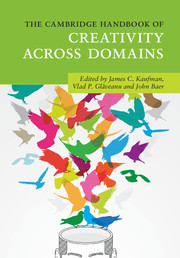Book contents
- The Cambridge Handbook of Creativity Across Domains
- The Cambridge Handbook of Creativity Across Domains
- Copyright page
- Dedication
- Contents
- Figures
- Tables
- Contributors
- Acknowledgments
- Part I Creativity and Domain
- Part II Creativity in the Traditional Arts
- Part III Creativity in the Sciences
- Part IV Creativity in Business
- 18 Studying Creativity across Different Domains
- 19 The Relationship Between Marketing and Creativity
- 20 Creative Leadership
- 21 Creativity in Business and Technology
- 22 Creativity in Design
- 23 A Minimalist Model for Measuring Entrepreneurial Creativity
- Part V Newer Domains for Creativity Research
- Part VI Creativity in Everyday Life
- Part VII Conclusion
- Index
- References
21 - Creativity in Business and Technology
Educational Technologies
from Part IV - Creativity in Business
Published online by Cambridge University Press: 15 September 2017
- The Cambridge Handbook of Creativity Across Domains
- The Cambridge Handbook of Creativity Across Domains
- Copyright page
- Dedication
- Contents
- Figures
- Tables
- Contributors
- Acknowledgments
- Part I Creativity and Domain
- Part II Creativity in the Traditional Arts
- Part III Creativity in the Sciences
- Part IV Creativity in Business
- 18 Studying Creativity across Different Domains
- 19 The Relationship Between Marketing and Creativity
- 20 Creative Leadership
- 21 Creativity in Business and Technology
- 22 Creativity in Design
- 23 A Minimalist Model for Measuring Entrepreneurial Creativity
- Part V Newer Domains for Creativity Research
- Part VI Creativity in Everyday Life
- Part VII Conclusion
- Index
- References
Summary
Ever since the introduction of desktop computers in schools, the degree to which technology constrains or enables students’ creativity has been explored in a number of guises and continues to color our understanding of the current trends in education. Because a central objective of educational technology is to redesign our tools and environments to enable new forms of teaching that make learning more efficacious, educational technologies offer new ways to think about and to measure creativity, teach creative thinking, and deepen creative expression. This chapter offers a broad survey of creativity research within this domain, presenting the definitions and constructs that are most important to the conceptualization of creativity with educational technologies and suggesting future considerations for the study of creativity in this area.
- Type
- Chapter
- Information
- The Cambridge Handbook of Creativity across Domains , pp. 381 - 402Publisher: Cambridge University PressPrint publication year: 2017



